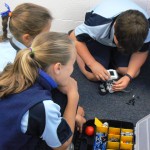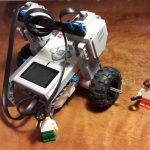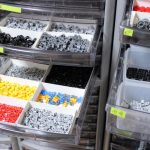Chris Rogers, professor at Tufts University, explains why STEM education should be taught in the classroom in this video published by LEGO Education. See below for a transcript.
Transcript
My name is Chris Rogers and I’m a professor here at Tufts University and I wanted to talk a little bit about STEM education in the classroom, that is, learning science, technology, engineering and math together as one coherent unit.
So the first question that immediately comes up is well why STEM? Why should we be teaching science, technology, engineering and math in classrooms? And, one of the first questions that comes up there is what’s the difference between science and engineering? And so I guess to start there, science is really trying to understand the world around you, whereas engineering is trying to change the world around you.
So as we’ve seen over the last couple of hundred years, engineering has made huge strides in completely changing the world around us, from transportation to the internet and sharing and communication. And it’s important as kids grow older that they understand the implications of these change.
To understand those implications they need to actually understand something about how these decisions are made – how do we engineer, how do we problem solve, how do we invent, and that’s what we want to see happening in classrooms. So this means opportunities for kids to drive their own learning, to come up with their own ideas and their own inventions. And it’s important that these are integrated experiences together; instead of going to science class and then to math class and then to engineering class, that all of these feed upon each other to build a better story. So, to take and learn science and engineering and mathematics and technology all at the same time as an integrated course as opposed to separate courses. And in fact a lot of schools now are even looking at integrating the arts in there as well and talking about STEAM instead of STEM.
As we bring STEM to the classroom though it’s important for us to look at the science of learning, of understand how the brain actually learns – how does the brain take in information? Retain information? Access information? And so if you look across the research of learning, you’ll notice a couple of things very quickly.
The first is that different brains learn differently, that we don’t all learn in the same way, just like we don’t all have the same tastes, we don’t all have the same abilities in sports, we also don’t all learn in the same way. So what might have worked for you as a teacher to learn some material or for you as an individual might not work then for the person whom you’re trying to teach. So the only solution is to take the different subjects and teach in many different ways, so through projects, through lecture, through experiments, and to try and make it so that at least one of these ways will access every child in the classroom.
It’s also important to recognize the difference between memorization and understanding. So typically we tend to ask kids to regurgitate information to us a lot of times that doesn’t necessarily mean that they actually understand the material, and can we find better ways of actually seeing if they understood the material we’re asking them to learn. In that understanding it’s important to understand that students construct, or individuals construct their own knowledge and so how do we actually get them to construct the same knowledge that we have or the knowledge that we want them to learn?
And then finally one of the things that we spend a lot of time looking at, is what really catalyzes engineering thinking? What causes kids to start thinking like an engineer, that is, stop following directions and start thinking on their own, start balancing out constraints and ideas.
So I wanted to quickly talk a little about who we are, so I’m part of a Center for Engineering Education and Outreach at Tufts, and at the Center we actually try and do the same thing of bringing together different disciplines to work together. So we have education doctoral students trying to understand how the brain actually learns information sitting right next to engineering doctoral students that are trying to develop new tools that’ll help kids learn materials better, and then we work with thousands of teachers all around the world to actually bring this material into classrooms and see how well it works, and then get feedback from those teachers to try and change both the tools and our understanding of learning.
We work with schools all around the world from Europe to Asia, to Australia to North America, and we try and involve more and more schools, more and more different cultures and backgrounds, because all of these help us look at learning in different ways. And in looking at all of these different ways and learning and all the different research, one of the things that I have started to realize is that there are many, again, many different ways to teach, but to step back and think well what are you actually trying to do when you teach?
And I think what we’re trying to do is we’re trying to take some idea, some story that we have in our head and we’re trying to put it in the head of our students. We have an understanding of how gravity works, we have an understanding of why a bridge works and so on and we’re trying to get the kids to have that same understanding.
And I see it as sort of three different ways that we can get that understanding into the head of the students. The first is we can simply tell them our understanding, we can explain to them how we understand gravity to work or the bridge to work. The second is we can show them, and that can be having them listen to other people’s understandings, it can be having them follow a recipe of some form, whether it’s building instructions or laboratory instructions, where they’re still looking at our story but they’re interaction with a different way than just listening to us talk. And then third is to actually enable them to come up with their own story, and as they come up with their own story to constantly argue our story with their story until we can realign their understanding until it is similar to ours.
So, again, there’s no right way to teach and it’s actually a balance of these three different things that make a great classroom, and that balance will change from person to person and from day to day. But, you can think about it there are some subjects that lend themselves more towards telling, such as safety precautions and so on, and some that lend themselves more to enabling, where you actually are trying to get, elicit opinions from kids. And sometimes, eliciting those opinions should happen actually before you start telling them what other people think, so, if we’re trying to explain concepts of say electricity, maybe have them play around with electrical circuits first, and through that playing around they start to come up with opinions and with questions, and then you bring in the ideas of others.
So what is this sort of balance between telling, showing, and enabling mean in the classroom? It’s a different type of classroom than what we’re familiar with. Most of the classrooms we know are ones where we spend a lot of time telling and maybe not so much time enabling. As soon as we start to enable, different things pop up, so we need classrooms where kids can take risks and fail. They can iterate again and again on their solution.
As you come up with your own idea and your own understanding obviously it’s not going to be exactly right the first time and so you have to continually test it, find evidence to support it, and through that iterate and make mistakes. We need classrooms where students can drive their own learning, so instead of the teacher determining all of the things the student is going to learn, the student determines some of those. If we can create environments where kids are taking risks, where kids are trying to solve their own problems, I think you’ll rapidly see we come up with environments where there’s no one right answer to the problem so there’s many different solutions that kids are finding as to how to solve the problem.
This is important, and I think it’s one of the basic fundamental attributes of one of these new classrooms, one that celebrates a diversity of solutions. So as opposed to classrooms today where everybody’s trying to get the same right answer, we’re looking for classrooms where everybody has a different answer, because if everybody has a different answer, they’ll start to learn from each other, and they’ll start to ask each other questions and make each other think more about what they’re learning.
We also I think need classrooms where instead of making sure that everybody learns exactly the same thing, we get classrooms where different people become experts in different areas. So some of them might be better at the artist side of the problem, some of them might be better at the computer programming side of the problem, some of them might be better at the fabrication side of the problem, and how can we promote this distributed expertise instead of forcing everybody to learn exactly the same things.
So I think now is a great time to actually start experimenting with a lot of these things in classrooms. Countries all over the world are very interested in how do we get STEM education in the classroom, how do we get our kids understanding how to invent, and how to be creative, and how to take those risks?
So the first thing we need to do is we need to be able to have the room to experiment and try things in the classroom that means, when we think about creativity of the child, we also should be thinking about creativity on the side of the teacher. Give the teacher a time and space and resources to try out new things with his or her students, to experiment. We need to find more ways that we allow these students to drive their own learning, so become active parts in their learning as opposed to just passive receivers of information.
And of course through all of this we need to find ways of weaving in the learning standards of the particular country or state. It is important that children learn these different things in the standard, it’s just whether or not we can do it in a way that they’re interested and excited about learning it as opposed to us spoon-feeding it to them.
So the one thing that hopefully you really will take away from this is the idea that we need as teachers to listen to students’ ideas, so it’s important that students have their own opinions in class, and you can tell if the program is successful in your class because students have their own opinions.
So I’d like to end with an invitation, one of the things we’ve been trying to work on is develop communities of teachers that are doing this in their classroom, finding ways to bring different teachers with different ideas and different students together and sharing these ideas, and we do this through virtually, through LEGOengineering.com, or physically through LEGO engineering conferences around the globe, and I invite you and ask you to participate in this and share with us what you’ve done, so that others can learn from the successes that you’ve had.
Thank you very much.
Rob Torok
Latest posts by Rob Torok (see all)
- Obstacle Course - 26 August 2020
- Crash Test Dummy - 26 August 2020
- The Wave - 21 May 2020
- Build X - 20 May 2020
- Build a Duck - 20 May 2020


